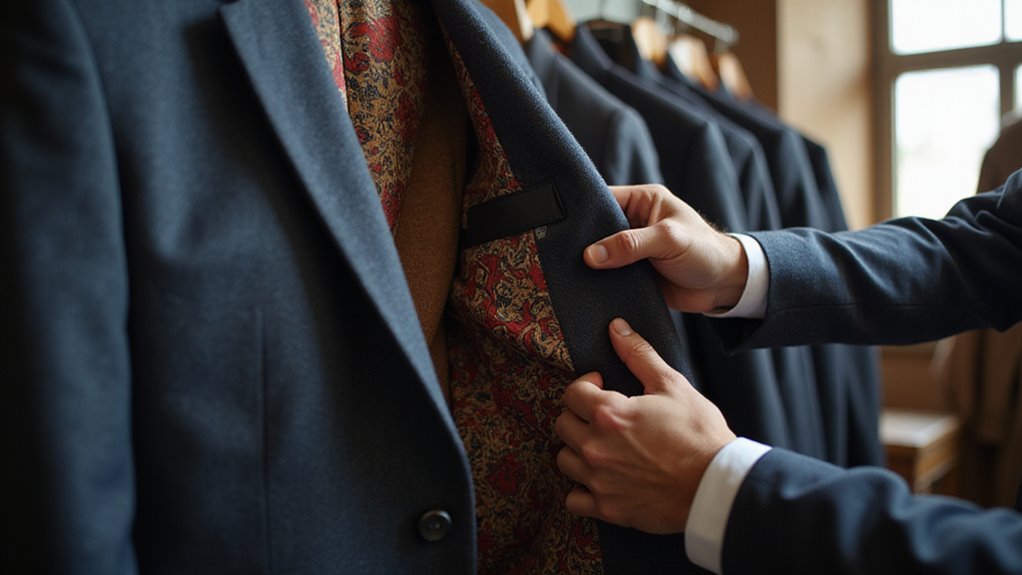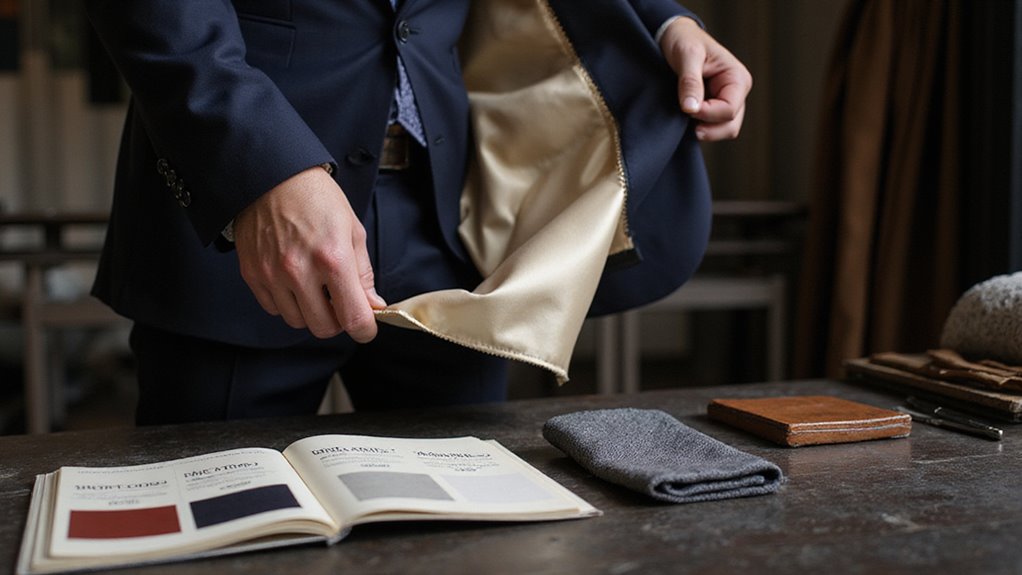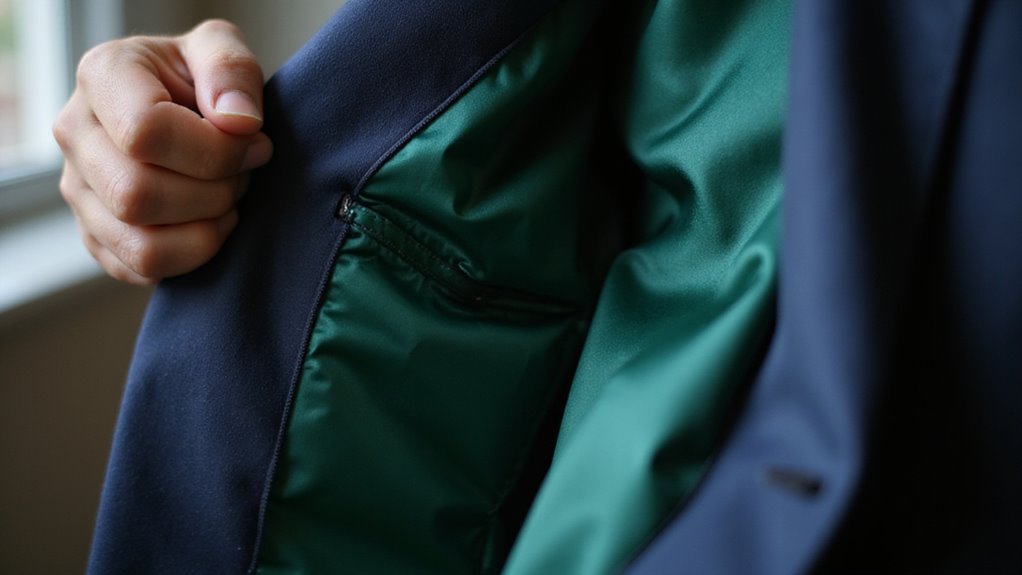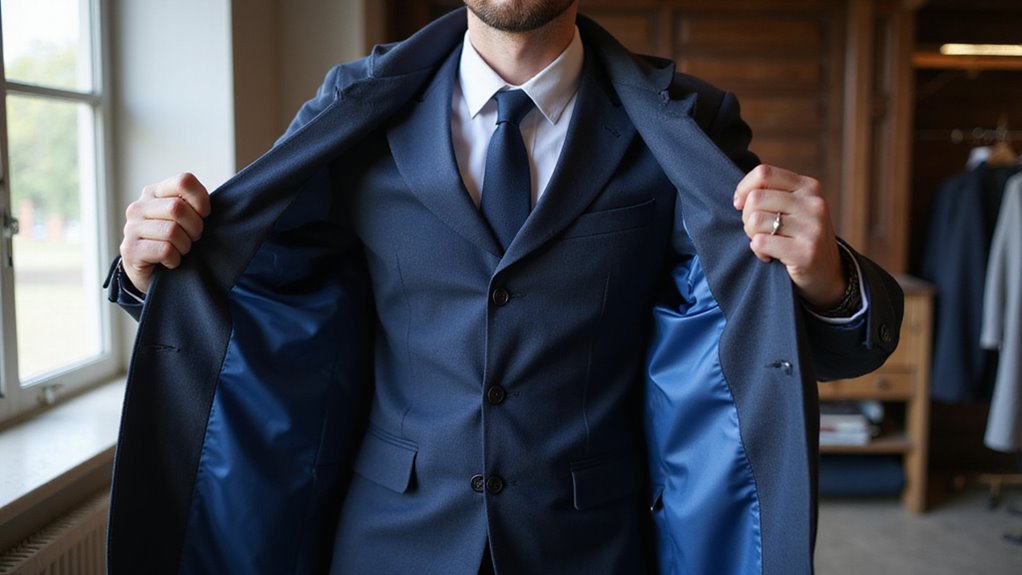Choosing the best lining for your suit jacket can feel overwhelming. Many options exist, each with different qualities and effects. If you pick the wrong lining, your jacket might feel hot, look bulky, or wear out quickly. Comfort and appearance suffer when you overlook the lining.
Many people focus only on the outer fabric and ignore the lining. This mistake leads to frustration when the jacket feels wrong or does not last. You might regret your choice if you do not consider lining material and construction.
The best lining for your suit jacket balances comfort, breathability, durability, and style. You can enjoy a better fit and longer-lasting suit if you choose wisely. This blog will guide you through the process and help you pick the perfect lining for your needs.
Key Takeaways
- Choose lining materials like silk or Bemberg for luxury and breathability, or synthetics for durability and affordability.
- Match lining thickness and breathability to the jacket’s season—lightweight for summer, thicker for winter.
- Consider eco-friendly options like viscose or recycled polyester for sustainability and easy maintenance.
- Select colors and patterns that complement or contrast with your suit, expressing personal style or keeping a classic look.
- Factor in budget, as premium linings and customization increase costs but improve comfort, durability, and overall suit quality.
Understanding the Purpose of Jacket Linings

A jacket lining improves comfort and function. It makes the inside look nice and can show off personal style. The lining protects the outer fabric and helps your jacket last longer. It also makes putting the jacket on and taking it off easier. In the past, special linings showed high-quality tailoring. Today, you can still choose classic or modern styles for linings. A good lining also helps with breathability and keeps you from getting too warm.
If you want a comfortable and stylish jacket, consider the lining carefully. Just like pre-designed templates save time and enhance workflow in graphic design, choosing the right jacket lining streamlines your experience and adds a professional touch to your wardrobe. Incorporating the concept of attention to details—such as selecting the right lining material—can elevate both the look and functionality of your suit jacket.
Common Materials Used for Suit Linings
When you choose a suit lining, you’ll weigh classic silk against a range of synthetic alternatives like polyester or viscose. Each material offers distinct advantages in breathability, moisture management, and overall comfort. Understanding these differences helps you match performance with your personal preferences and intended use.
Just as selecting the right file format in digital imaging ensures optimal performance and compatibility, choosing the best lining material can greatly affect your suit’s comfort and suitability for different occasions. Many suit mockup templates offer visual examples of various linings and textures, providing inspiration and helping you envision the final look of your tailored jacket.
Silk Versus Synthetic Options
Silk and synthetic materials are the main choices for suit linings. Silk gives a shiny look and feels very smooth. Its thin profile adds little weight to the suit. If you want more affordable options, synthetics like polyester or viscose work well. Synthetics come in many thicknesses and resist wear better than silk.
Here is a simple comparison:
| Feature | Silk Lining | Synthetic Lining |
|---|---|---|
| Thickness | Very thin and light | Can be thin or thick |
| Color | Bright, shiny colors | Wide color selection |
| Durability | Can wear out quickly | Usually lasts longer |
If you want luxury, choose silk. If you want strength and value, pick synthetics.
Breathability and Comfort Factors
Breathability and comfort depend on the suit lining you choose. Natural fibers like Bemberg, silk, and cupro are best for airflow. These linings let heat escape and help keep you cool. They also wick away sweat and stop the fabric from feeling sticky. Polyester and acetate are synthetic linings that can trap heat and reduce ventilation. This may make the suit feel less comfortable if worn for long periods.
The lining’s look also affects comfort and movement. A smooth, light lining helps the suit drape well and reduces friction. If you want a comfortable suit, select a lining that feels soft and does not add bulk. This makes the suit look good and stay comfortable all day.
The Pros and Cons of Silk Linings

When you choose silk linings, you get unmatched breathability and a smooth, comfortable feel against the skin. However, silk’s durability can’t compete with sturdier synthetics, so you’ll notice more wear over time. If you want a lining with a luxurious sheen and refined drape, silk offers a distinct advantage in appearance.
For those considering design customization, detailed visualization tools—common in modern mockup processes—can help you preview how silk’s texture and color will enhance your jacket before making a final choice. For anyone weighing their options, it’s important to recognize that silk linings are often favored in bespoke suits for their superior comfort and elegance.
Breathability and Comfort Levels
Silk is very breathable and comfortable for suit jacket linings. The natural fibers help keep your body at a steady temperature. Silk feels light on your skin, so it does not add bulk. If you wear your jacket for long hours or in warm weather, silk helps keep you cool. The fabric also wicks moisture away, which keeps you dry.
Silk linings look elegant because of their natural shine. The smooth texture lets your jacket move easily as you do. If you want a lining that feels good and looks stylish, silk is a top option.
Durability Over Time
Silk linings look elegant but are not very durable over time. The natural fibers in silk can fray in high-friction areas. If the lining is not reinforced well, thinning or tears can develop. Silk also fades and wears down faster than some other linings. The table below compares silk with other options:
| Characteristic | Silk Lining |
|---|---|
| Abrasion Resistance | Moderate-Weak |
| Tear Strength | Moderate |
| Maintenance Needs | High (Delicate) |
Proper installation and gentle care can help silk last longer. If you want more durability, consider alternative lining materials.
Luxury Appearance Choices
Silk linings give a suit jacket a clear and noticeable sense of luxury. The fabric has a shiny look and feels very soft. If you want comfort and style, silk is a strong choice. This fabric also lets the jacket breathe well. However, silk needs careful handling because it is delicate.
- Pros:
- The rich shine makes the jacket look elegant.
- The smooth feel adds comfort and easy movement.
- A light weight keeps the jacket comfortable to wear.
- Cons:
- The fabric can wear out quickly if used often.
- Cleaning silk demands special methods and care.
- Prices for silk are higher than for most other linings.
You should consider these points before choosing silk for your jacket.
Why Choose Cupro for Your Jacket Lining

Cupro is a top choice for jacket linings because it is both luxurious and practical. This fabric is made from cotton linter, a by-product of cotton. It is a sustainable option for anyone who wants to reduce their environmental impact. Cupro feels soft and smooth, giving your jacket a high-end touch. The fabric breathes well and manages moisture, keeping you comfortable. It also resists static, so your clothing stays neat. Tailors like cupro because it drapes easily and is simple to work with.
If you want deep and bright colors, cupro takes eco-friendly dyes very well. In the world of tailoring, choosing the right lining is as essential as selecting peak lapels or other key suit features for a balanced and sophisticated look. Choosing cupro means you care about both quality and the environment. Just as the best lining choice can elevate your jacket, selecting the right outer garment—such as a waistcoat or vest—can enhance your overall style and comfort.
Exploring Bemberg as a Lining Option
Bemberg is a strong choice for suit jacket linings. It is made from regenerated cellulose fibers. If you want a vegan and eco-friendly lining, Bemberg is a good option. The fabric feels smooth and helps wick away moisture.
Bemberg linings slide easily against shirts, which helps movement. The material lets air pass through, so it keeps you cool. Its antistatic nature reduces static and keeps the jacket looking neat. Using Bemberg also supports material waste minimization, since its properties can be tested and refined through mockups before committing to large-scale production.
If you value sustainable tailoring, Bemberg combines style and comfort with environmental care. Designers often use Bemberg because its high-quality product mockups allow for realistic visualization before the final jacket is produced. Consider Bemberg for a refined and practical suit lining.
The Benefits of Polyester Linings

When you choose polyester linings, you gain impressive durability and resistance to daily wear. This fabric’s moisture-repellent properties keep your suit jacket comfortable and fresh in varied conditions. You’ll also notice that polyester offers significant cost savings without sacrificing essential performance.
Just as visual consistency enhances brand presentation in digital marketing, choosing a uniform polyester lining ensures your suit jackets look sharp and cohesive across your entire wardrobe. Additionally, polyester linings contribute to professional appearance by maintaining sharp visual details and enhancing the overall look of your suit jackets.
Durability and Longevity
Polyester linings last a long time and are very durable. This material is strong and does not tear or fray easily. Polyester keeps its shape even if you wear your suit often. If you need a lining that handles frequent dry cleaning, polyester is a good choice. Tailors use polyester because it is easy to work with and stays in place.
Polyester resists daily friction and keeps a smooth finish. Its colors stay bright after many washes. The lining will not sag or bunch if made from polyester.
Moisture Resistance Qualities
Polyester linings resist moisture because the fibers do not absorb water. The fabric keeps rain, sweat, or spills away from your jacket’s inside. If you choose polyester, you get a lining that dries quickly and does not stay damp. This helps your suit feel comfortable and look neat.
Polyester also helps prevent stains. Liquids stay on the fabric’s surface, making cleanup easier. If you wipe spills quickly, stains are less likely to set. This makes polyester a good choice for daily wear or changing weather.
Cost-Effectiveness Explained
Polyester linings are a cost-effective option for jacket interiors. They keep prices low because they are made efficiently. If you want a durable lining without spending much, polyester is a practical choice. Compared to silk or viscose, polyester costs much less and still offers good quality. Polyester linings also help save on cleaning because they are easy to care for.
- Affordable choice: Polyester costs less than most other lining materials.
- Simple maintenance: It is easy to wash, and it does not wrinkle easily.
- Durable material: Strong fibers help prevent tears and last longer.
Choose polyester if you need a budget-friendly and reliable lining.
Comparing Viscose and Acetate Linings

When choosing a suit jacket lining, you will usually see viscose and acetate as main options. Viscose and acetate are both semi-synthetic fibers, but they have important differences. Viscose is more eco-friendly because it comes from renewable wood pulp. Acetate is smooth and lightweight, but it wrinkles and tears more easily. If you want a lasting and comfortable lining, viscose is often the better choice.
Choosing linings that support sustainable fashion initiatives not only benefits the environment but also ensures better quality in your garments. Designers often use mockups as essential tools to visualize how different linings will look and perform within the jacket, helping clients make more informed choices.
| Feature | Viscose | Acetate |
|---|---|---|
| Sustainability | High—made from wood pulp | Moderate—not as eco-friendly |
| Durability | Resists wear and tear | Easily wrinkles or tears |
| Comfort & Feel | Soft and breathable | Smooth, but less strong |
Pick the option that best fits your needs.
How Lining Affects Jacket Breathability
The lining affects how much air can pass through a jacket. Thin linings, like viscose or silk blends, let more air move. Thick linings reduce ventilation and can make you feel warmer. If you pick a dark lining, it can hold more heat. Light colors reflect heat and help you stay cooler.
Loose fabric weaves also improve airflow inside the jacket. Choose thin, light-colored linings for hot weather or active use. The choice of lining can also influence whether your jacket feels more like a sport coat, a blazer, or a formal suit, based on its breathability and overall comfort.
Durability and Maintenance Considerations
The lining’s durability affects how long your jacket will last. A strong lining resists wear, tearing, and shape loss. Silk and viscose feel smooth but often need careful cleaning and early replacement. Modern options like cupro and recycled polyester are tough and environmentally friendly. If you want less maintenance, pick a lining that handles dry cleaning and spot cleaning well. Weak linings may fray or fade quickly. A dense weave lasts longer and keeps the jacket looking sharp.
Choosing the Right Lining for Seasonal Wear
You’ll want to match your suit lining to the season by prioritizing breathability in warmer months and insulation for winter comfort. Fabrics like Bemberg or lightweight silk regulate airflow, while heavier viscose or quilted linings retain warmth when temperatures drop. For all-year wear, consider moisture-wicking materials that manage perspiration without sacrificing elegance.
Breathability for Warmer Months
Breathable linings are important for comfort when it is warm. Good lining choices help air move and keep you dry.
- Bemberg or cupro linings pull sweat away and let air flow through.
- Half-lined or unlined jackets allow heat to escape more easily in hot weather.
- Mesh or perforated linings increase airflow while keeping the jacket’s shape.
Choose these options if you want to stay cool and look sharp in summer.
Insulation for Winter Comfort
Winter requires linings that keep you warm without feeling heavy. Flannel-backed and wool-blend linings hold in body heat well. These materials form a soft, comfortable layer against cold weather. Heavy or stiff fabrics should be avoided, as they may limit movement. Linings made of Bemberg or quality viscose are soft and insulate well. If temperatures are very low, quilted linings provide extra warmth. Smooth lining surfaces help you put on the suit easily over sweaters. Choosing the right lining ensures warmth and comfort while keeping the suit looking sharp.
Moisture Management Materials
The right lining helps manage sweat and keeps your suit jacket comfortable. Good linings pull moisture away from your skin. These linings also stop odors and help the jacket keep its shape. Lightweight fabrics, like Bemberg or polyester, work best in hot weather.
Heavier linings are better for cooler days. Always make sure the lining color matches the jacket. If you want to stay cool and dry, choose moisture-wicking fabrics. If you value style, coordinate the lining with the jacket’s exterior.
Patterns and Colors: Making a Statement
Your suit jacket lining is a chance to show your style. Patterns and colors inside the jacket can make a statement. If you want to stand out, pick bold designs or bright shades. Geometric shapes, stripes, polka dots, or solid colors all send different signals. Choose contrasting colors for a strong look. Select matching tones for a calm effect. The right mix makes your lining both stylish and useful. Here are some pattern and color ideas:
| Pattern/Color | Statement Effect |
|---|---|
| Bold Paisley | Artistic, adventurous |
| Classic Stripes | Refined, structured |
| Vibrant Solids | Modern, energetic |
| Monochrome | Subtle, minimalist |
| Polka Dots | Playful, approachable |
Matching Lining to Your Suit Fabric
To match a lining to your suit fabric, focus on weight and texture first. The lining should be similar in weight to the suit fabric. If the suit is heavy wool, choose a thick lining. If the suit is light linen, use a thin, breathable lining. A smooth lining helps the jacket slide on easily. Color and pattern can match or contrast, but always ensure the lining suits the fabric’s weight and feel.
- Choose a lining weight close to the outer fabric to keep the suit’s shape.
- Select a smooth lining for easy wear, especially with textured fabrics.
- Pick lining colors and patterns that look good with the suit but keep function in mind.
Customization Options for Unique Looks
You can make your suit jacket unique with different customization options. Modern tailors offer many lining colors to choose from. These colors can match or contrast with your jacket fabric. Rich jewel tones add vibrancy, while neutral shades keep it classic.
Personalized embroidery, like your initials or a special date, is also possible. Embroidery adds a special touch inside your jacket. Specialty materials such as silk blends or patterned viscose are available. These materials bring comfort and style to your suit. If you want a unique look, consider these customization choices for your jacket lining.
Budgeting for High-Quality Linings
Budgeting for high-quality linings means planning for extra costs. Premium materials and custom colors increase the total price. Silk and Bemberg fabrics cost more than polyester. These materials offer better comfort and longer wear. Detailed patterns often raise tailoring costs. Special color requests may add dye or sourcing fees. If you want a top-quality lining, you should expect higher expenses. Careful budgeting helps you get the best value for your suit.
Conclusion
If you want your suit jacket to last longer, you should pay attention to the lining. When you choose the right lining, you add comfort and style. The ideal fabric can improve the way your jacket feels and moves.
If you live in a warm climate, you might select a lightweight and breathable lining. If you prefer a classic look, you could choose a neutral color or subtle pattern. When you care about sustainability, you should consider eco-friendly lining materials.
If you want your suit to feel unique, you can pick a lining that matches your personality. If you are ready to design a suit with the perfect lining, try Custom Mockup. Explore your options and create a suit that fits your needs today.



No Comment! Be the first one.